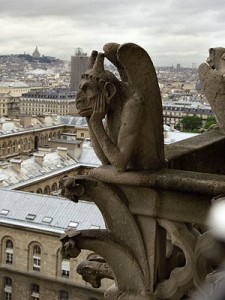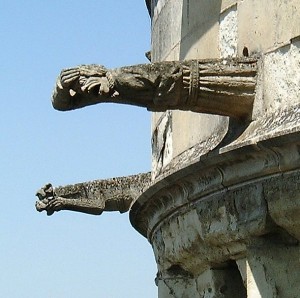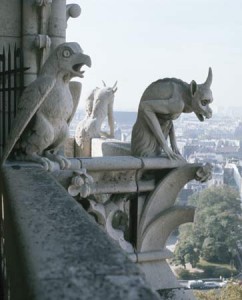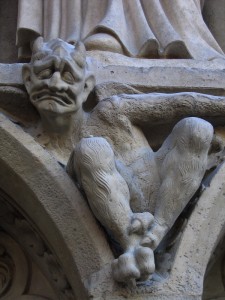 There are a few items in the fantastic that I am passionate about, and one of those happens to be gargoyles, or more specifically as we will see below, grotesques. Each Halloween season I try to add a few to my collection. They have been popular figures in culture for some time, including on contemporary pop culture. Consider not only gargoyles in connection with Halloween, but also that they have appeared as minor figures in Disney’s animated The Hunchback of Notre Dame, and they were part of their own animated television series by the name Gargoyles from 1994 to 1997.
There are a few items in the fantastic that I am passionate about, and one of those happens to be gargoyles, or more specifically as we will see below, grotesques. Each Halloween season I try to add a few to my collection. They have been popular figures in culture for some time, including on contemporary pop culture. Consider not only gargoyles in connection with Halloween, but also that they have appeared as minor figures in Disney’s animated The Hunchback of Notre Dame, and they were part of their own animated television series by the name Gargoyles from 1994 to 1997.
But what is the history of these interesting creatures? Gary Varner helps us understand these interesting creatures. Varner has over twenty books in print about folklore, mythology, Native Americans, ancient symbols, mythic creatures and cultural diffusion. Those directly related to the topic of this interview include Gargoyles, Grotesques, and Green Men: Ancient Symbolism in European and American Architecture (lulu.com, 2008), and Strangely Wrought Creatures of Life and Death: Ancient Symbolism in European and American Architecture (lulu.com, 2006). His website, http://www.authorsden.com/garyrvarner, is visited by readers in over 40 countries. Over 900 university and municipal libraries around the world have copies of his books, including the Smithsonian Institution’s Museum of the American Indian and the British Museum.
In an attempt to stay current in folklore studies, he maintains membership in the American Folklore Society and the Royal Anthropological Institute. His articles have appeared in American, British and German journals.
Varner has traveled extensively to document his material, most notably to England, Wales, Ireland, Canada, Yucatan, and across the United States.
Following is our discussion of the gargoyle.
TheoFantastique: Gary, thanks for your willingness to discuss your research on this topic. How did you come to pursue the specific study of research topics like gargoyles within the disciplines of folklore and mythology studies?
Gary Varner: I had seen many gargoyles and grotesques on my trips to the British Isles and fell in love with their monstrous look. I found that in the United States people are so focused on their daily errands that we seldom look up! I made a point to do so and was amazed at how many of these ancient icons are present on our buildings as well. I decided to do some research to try to determine the historic basis for these objects and how they have been incorporated in contemporary society.
TheoFantastique: What is the etymological origin and meaning of “gargoyle,” and what types of historical and cultural influences lie behind our present conceptions of these artistic creations?
 Gary Varner: The word “gargoyle” is derived from the French “gargouille” from the Latin “gurgula” meaning “throat” or “gullet.” Gargoyles serve a very utilitarian purpose as water spouts. In fact, only these features constitute a true gargoyle—anything else is considered a “grotesque.” What we consider the classic gargoyle today originated during the early 12th century CE, however decorative water spouts can be traced back to the days of ancient Rome, Egypt, Greece and the Etruscans. The images were different however. The ancient Greeks used the lion as the decoration rather than the dragon. The image of the classic gargoyle we have today began around 1150 CE near Paris, France. It seemed to have struck a cord among architects and the public alike as within a hundred years gargoyles appeared throughout Europe. Prior to the 12th century gargoyles appeared singularly. It wasn’t until the 12th century that they appeared in rows or “rookeries.”
Gary Varner: The word “gargoyle” is derived from the French “gargouille” from the Latin “gurgula” meaning “throat” or “gullet.” Gargoyles serve a very utilitarian purpose as water spouts. In fact, only these features constitute a true gargoyle—anything else is considered a “grotesque.” What we consider the classic gargoyle today originated during the early 12th century CE, however decorative water spouts can be traced back to the days of ancient Rome, Egypt, Greece and the Etruscans. The images were different however. The ancient Greeks used the lion as the decoration rather than the dragon. The image of the classic gargoyle we have today began around 1150 CE near Paris, France. It seemed to have struck a cord among architects and the public alike as within a hundred years gargoyles appeared throughout Europe. Prior to the 12th century gargoyles appeared singularly. It wasn’t until the 12th century that they appeared in rows or “rookeries.”
TheoFantastique: How might we classify the gargoyle in terms of other symbolic and mythical creatures with which it might co-exist if you will?
Gary Varner: Gargoyles can take the form of most any real or mythical beast. I have seen them in the form of goats, dragons, lions, fish, eagles, parrots and in human form. Many times they have been carved in a whimsical fashion and many times in a very terrifying form. The old architects of the middle ages obviously had a very good sense of humor in that some of their gargoyles were caricatures of real people.
TheoFantastique: What types of forms do gargoyles take? How have artists expressed them?
Gary Varner: Since their function is to divert water from roof tops the form is somewhat restricted. However artistic renditions have taken any number of forms from the whimsical to the religious to the horrifying. Their forms have changed over time with the more grotesque forms originating during the Romanesque period and the more sedate and classical forms more common during earlier periods. Some have suggested that the gargoyle forms themselves represent Christian symbols of evil and sin but others believe that the forms actually represent the individual personalities of the stone carvers and their experiences, values and belief systems. Many of them more than likely had roots in paganism and brought many pagan traditions into their art.
TheoFantastique: In what types of buildings and structures are gargoyles found?
 Gary Varner: Originally, gargoyles were created for ecclesiastical structures. This may be simply because they were the tallest buildings with the greatest need for water runoff. Why they suddenly appeared in the 12th century on churches in that particular form is unknown. A shift in their usage occurred in the 16th century when they were placed on secular buildings and the homes of the wealthy throughout Europe. Today they can still be found on churches and cathedrals but also on apartment buildings and commercial structures. Geographically the gargoyle appears where heavy European influence has been felt such as in New York where the Irish settled and across the Midwest where Germanic immigration occurred. That said I have seen them in San Diego, Sacramento and San Francisco as well as a number of small California municipalities. Perhaps the greatest concentration of them are in Pittsburgh, Pennsylvania where many government, church and commercial buildings are adorned with these images carved between 1880 and 1905. For some reason this time period seems to have been responsible for an explosion of creativity with both gargoyles and grotesques showing up in American architecture.
Gary Varner: Originally, gargoyles were created for ecclesiastical structures. This may be simply because they were the tallest buildings with the greatest need for water runoff. Why they suddenly appeared in the 12th century on churches in that particular form is unknown. A shift in their usage occurred in the 16th century when they were placed on secular buildings and the homes of the wealthy throughout Europe. Today they can still be found on churches and cathedrals but also on apartment buildings and commercial structures. Geographically the gargoyle appears where heavy European influence has been felt such as in New York where the Irish settled and across the Midwest where Germanic immigration occurred. That said I have seen them in San Diego, Sacramento and San Francisco as well as a number of small California municipalities. Perhaps the greatest concentration of them are in Pittsburgh, Pennsylvania where many government, church and commercial buildings are adorned with these images carved between 1880 and 1905. For some reason this time period seems to have been responsible for an explosion of creativity with both gargoyles and grotesques showing up in American architecture.
TheoFantastique: What is the meaning or meanings of their symbolism in different cultures and periods of history?
Gary Varner: I don’t believe that a “meaning” can be tied to any of these forms. They represent the traditions of the stone carver during the 12th century and they continued to the present day as a symbol of the past that we have come to love as a culture. Many of these artistic endeavors obviously have a Celtic theme. I have seen a gargoyle at Mission San Luis Rey in Southern California dating to 1798 that has a striking Celtic flavor. They represent the cultural identity of the artisan. Many of them may have been inspired by Christian bestiaries and were accepted by the priests as a religious symbol or fable.
 TheoFantastique: How, when and why did gargoyles come to be associated with Christian churches and cathedrals?
TheoFantastique: How, when and why did gargoyles come to be associated with Christian churches and cathedrals?
Gary Varner: I believe this occurred because the first were installed on Gothic cathedrals perhaps as Christian “spiritual scarecrows” to warn evil away from the church building. There has been some speculation as well that they were placed on churches to entice the “heathen” population to enter and be comfortable with pagan images in close proximity. This is one mystery that may never be solved though.
TheoFantastique: Is there any connection between the gargoyle and the Green Men, and can you summarize some of the background of this symbol?
Gary Varner: The Green Man could be a gargoyle if it had a water spout but I don’t believe any of the ancient Green Man forms do. Green Men are grotesques rather than gargoyles. A “grotesque” may have many of the design elements of the gargoyle but they have taken a totally divergent path. One scholar noted “Grotesque art, then, expresses the repressed.” Many grotesques such as the legendary sheela-na-gig, a grotesque female figure which rudely exposes its genitalia, are also found on ancient church edifices from the 8th century into the Christian era. Like the gargoyles the sheela’s became common during the 12th century and may have served as a warning against sexual sin. The Green Man, to the contrary, is an ancient symbol of rebirth, renewal and fertility. They are also located in many Christian churches across Europe. Perhaps the largest concentration are in Rosslyn Chapel in Scotland, long known for its Templar ties.
TheoFantastique: Gary, thank you so much for your research and writing on this topic, and for your willingness to discuss it here.





Thank you for this interview – really fascinating stuff! I’ve long admired gargoyles, and if I could put one or two on top of my own home without my old-fashioned small town starting some sort of witch hunt, I’d do it. I do however, have a few smaller versions in my house…
Thanks for the links as well 🙂
Christine, thanks for sharing in our mutual enjoyment of these creatures.. I live in largely conservative Utah and have been surprised to see gargoyles or grotesques included as external home decorations in lighting and landscaping., so maybe the neighbors wouldn’t burn you at the stake if you had some of your own. But like you I tend to try to collect a few from my local stores during the Halloween season. Perhaps in the future I’ll try to purchase some larger more artistic representations of these mythical beasties. Glad to see a fellow LOTTDer as a gargoyle fan.
Once again, Gary Varner has shown his scholarship and the depth of his research on whatever subject he chooses to approach. My meager collection of grotesques is smiling – at least I think that’s a smile. Thanks to Gary for another good work.